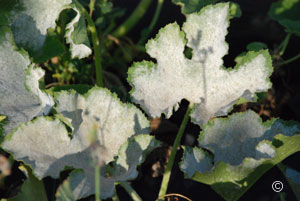Many vegetable crops are susceptible to powdery mildew. Plants affected with this fungal disease usually appear coated with talcum powder or flour. Some plants such as tomatoes, peppers and onions may only have yellow colored leaf patches. As the disease progresses, leaves, buds and stems are distorted. Leaves drop prematurely and flower buds fail to open.
What happens when plants have powdery mildew?
Powdery mildew damages plants by decreasing photosynthesis and removing nutrients from the host plant. Infections weaken plants and increase susceptibility to further pest problems. Powdery mildews are host specific. The species that affects cucurbits (cucumber, cantaloupe) for example, will only affect cucurbits.
What can cause powdery mildew?
 Vegetable gardens with poor air circulation and abundant shade are prone to infection. Mildews do not require free moisture, but only need warmth and adequate humidity to grow and develop. Dense plantings create microclimates with sufficient humidity to support mildew populations.
Vegetable gardens with poor air circulation and abundant shade are prone to infection. Mildews do not require free moisture, but only need warmth and adequate humidity to grow and develop. Dense plantings create microclimates with sufficient humidity to support mildew populations.
How can I prevent powdery mildew?
Always plant vegetable crops in the full sun. Prune or thin plants to increase light and air circulation, reducing humidity. Direct water applications to soil, rather than into the leaf canopy. Avoid excessive fertilizer applications as this creates tender, succulent, susceptible tissue. When available, plant mildew resistant vegetable varieties.
Most fungicides are applied as preventives before powdery mildew appears or when it is in its early stages. Some examples are sulfur and potassium bicarbonate. Read label directions before applying sulfur as it can damage some melon and squash varieties. Do not apply sulfur when temperatures are near or above 90 degrees F.
Eradicant fungicides can kill an existing powdery mildew infection and should be applied at the earliest signs of the disease. Neem based fungicides and horticultural oils act as eradicants. Do not apply oils to drought stressed plants or within two weeks of a sulfur spray. Do not apply oils when temperatures are above 90 degrees F.



